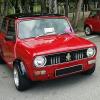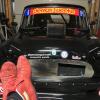A classic Mini can be safely revved to 6000 rpm or just over. If the engine produces maximum power at, say, 5800 rpm, those are the revs at which maximum speed should be achieved. Thus it needs to be geared to achieve this.
If geared too high, say a 998 with a 2.9:1 FDR, it may actually be faster flat out in 3rd rather than in top.
Changing from, say, 12" wheels to 10" won't make any significant difference because the rolling radius of the 12" with the lower profile tyres will give approximately the same rolling radius, certainly no more than about 3% difference.#
The higher the revs at which max power is produced, the lower the FDR needs to be.
There are so many variables in this maximum speed business that it is not easy to explain them all, but the key thing is gearing. The 998 Cooper gave its maximum speed from 55 bhp which was produced at around 5800 rpm and with a 3.76:1 FDR that gave about 88 mph at those revs.
The Cooper 'S' 1275 with 75 bhp had a 3.44:1 FDR and gave about 96 mph at the same sort of revs, i.e. 5800. So the additional 20 bhp only gave an additional 8 mph due to the drag increasing as the square of the speed. So double the speed = 4 x the drag. There is no answer to this and those who claim silly maximum speeds don't understand that their cars are governed by the laws of physics.
So to achieve 100 mph requires approximately 90 bhp and as the engine will be modified it will probably give this power at just over 6000 rpm, so it must be geared down to do this..
These figures ignores the torque curve which is needed to enable the engine to continue to 'pull' against the drag curve after changing up.
Another thing which improves max speed by way of drag reduction is to remove the huge wing mirrors and just fit a small rectangular A-post mounted mirror on the driver's side only. Removing any wheel-arch extensions and fitting narrower wheels & tyres will add a couple of mph at the top end as well. The huge 'Sportpack' arches do create a lot of additional drag - look at the cross-sectional area they present to the airflow.
As I said, it's complicated
.
i respect you but i would say you're wrong.. with my fairly modded 998 i did a GPS 160kmh which equates to 100mph.. i wasn't able to screenshot it but i will do it and post it here just so you'll know im not bulls**ting.. :)
Edited by daenesh, 05 May 2015 - 02:38 AM.


















